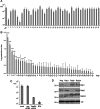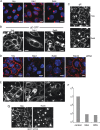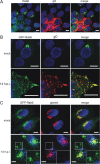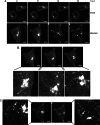Rab6 dependent post-Golgi trafficking of HSV1 envelope proteins to sites of virus envelopment
- PMID: 24152084
- PMCID: PMC4345966
- DOI: 10.1111/tra.12134
Rab6 dependent post-Golgi trafficking of HSV1 envelope proteins to sites of virus envelopment
Abstract
Herpes simplex virus 1 (HSV1) is an enveloped virus that uses undefined transport carriers for trafficking of its glycoproteins to envelopment sites. Screening of an siRNA library against 60 Rab GTPases revealed Rab6 as the principal Rab involved in HSV1 infection, with its depletion preventing Golgi-to-plasma membrane transport of HSV1 glycoproteins in a pathway used by several integral membrane proteins but not the luminal secreted protein Gaussia luciferase. Knockdown of Rab6 reduced virus yield to 1% and inhibited capsid envelopment, revealing glycoprotein exocytosis as a prerequisite for morphogenesis. Rab6-dependent virus production did not require the effectors myosin-II, bicaudal-D, dynactin-1 or rabkinesin-6, but was facilitated by ERC1, a factor involved in linking microtubules to the cell cortex. Tubulation and exocytosis of Rab6-positive, glycoprotein-containing membranes from the Golgi was substantially augmented by infection, resulting in enhanced and targeted delivery to cell tips. This reveals HSV1 morphogenesis as one of the first biological processes shown to be dependent on the exocytic activity of Rab6.
Keywords: Gaussia luciferase; Rab6; Rab6 effector; VSV-G; herpes simplex virus; post-Golgi carrier; secretion.
© 2013 The Authors. Traffic published by John Wiley & Sons Ltd.
Figures










Similar articles
-
The Rab6 post-Golgi secretory pathway contributes to herpes simplex virus 1 (HSV-1) egress.J Virol. 2024 Sep 17;98(9):e0059924. doi: 10.1128/jvi.00599-24. Epub 2024 Aug 13. J Virol. 2024. PMID: 39136459 Free PMC article.
-
Endocytic tubules regulated by Rab GTPases 5 and 11 are used for envelopment of herpes simplex virus.EMBO J. 2012 Nov 5;31(21):4204-20. doi: 10.1038/emboj.2012.262. Epub 2012 Sep 18. EMBO J. 2012. PMID: 22990238 Free PMC article.
-
Distinct sets of Rab6 effectors contribute to ZW10--and COG-dependent Golgi homeostasis.Traffic. 2014 Jun;15(6):630-47. doi: 10.1111/tra.12167. Epub 2014 Apr 11. Traffic. 2014. PMID: 24575842 Free PMC article.
-
Role of Rab GTPases in HSV-1 infection: Molecular understanding of viral maturation and egress.Microb Pathog. 2018 May;118:146-153. doi: 10.1016/j.micpath.2018.03.028. Epub 2018 Mar 16. Microb Pathog. 2018. PMID: 29551438 Review.
-
How Rab proteins determine Golgi structure.Int Rev Cell Mol Biol. 2015;315:1-22. doi: 10.1016/bs.ircmb.2014.12.002. Epub 2015 Feb 7. Int Rev Cell Mol Biol. 2015. PMID: 25708460 Free PMC article. Review.
Cited by
-
The Procaine-Based ProcCluster® Impedes the Second Envelopment Process of Herpes Simplex Virus Type 1.Int J Mol Sci. 2025 Jul 25;26(15):7185. doi: 10.3390/ijms26157185. Int J Mol Sci. 2025. PMID: 40806319 Free PMC article.
-
Herpes Simplex Virus 1 (HSV-1) Uses the Rab6 Post-Golgi Secretory Pathway For Viral Egress.bioRxiv [Preprint]. 2023 Dec 13:2023.12.13.571414. doi: 10.1101/2023.12.13.571414. bioRxiv. 2023. Update in: J Virol. 2024 Sep 17;98(9):e0059924. doi: 10.1128/jvi.00599-24. PMID: 38168379 Free PMC article. Updated. Preprint.
-
Rab27a facilitates human parainfluenza virus type 2 growth by promoting cell surface transport of envelope proteins.Med Microbiol Immunol. 2018 Apr;207(2):141-150. doi: 10.1007/s00430-018-0536-3. Epub 2018 Jan 27. Med Microbiol Immunol. 2018. PMID: 29374787
-
Identification of Host Factors Involved in Human Cytomegalovirus Replication, Assembly, and Egress Using a Two-Step Small Interfering RNA Screen.mBio. 2018 Jun 26;9(3):e00716-18. doi: 10.1128/mBio.00716-18. mBio. 2018. PMID: 29946045 Free PMC article.
-
Overexpression of caveolin-1 in inflammatory breast cancer cells enables IBC-specific gene delivery and prodrug conversion using histone-targeted polyplexes.Biotechnol Bioeng. 2016 Dec;113(12):2686-2697. doi: 10.1002/bit.26022. Epub 2016 Jun 9. Biotechnol Bioeng. 2016. PMID: 27241022 Free PMC article.
References
-
- Stenmark H. Rab GTPases as coordinators of vesicle traffic. Nat Rev Mol Cell Biol. 2009;10:513–525. - PubMed
Publication types
MeSH terms
Substances
Grants and funding
LinkOut - more resources
Full Text Sources
Other Literature Sources
Research Materials

